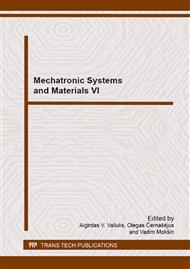p.595
p.603
p.609
p.615
p.621
p.627
p.633
p.640
p.646
The Analysis of Finishing Tooling Influence on Corrosion Properties of Stainless Steel
Abstract:
Angular momentum pumps are very often applied on-board ships. These pumps are used in cooling circuits of medium and high power engines, power plant boilers and in bilge, ballast and fire installations. Very extensive use of angular momentum pumps on board is linked with their numerous advantages. During operation, the wear of the marine hull, the rotor and the shaft seals takes place. The research attempts to increase the service life of shafts. The article presents the research results referring to the analysis of the influence of finish treatment (turning, grinding and burnishing) on the corrosion properties of steel applied to marine pump shafts. The research was performed on a roller of 40 mm in diameter made of X5CrNi18-10 (AISI 304 L) stainless steel. The turning process was carried out by means of a WNMG WF 080408 Sandvik Coromant cutting tool with replaceable inserts. The grinding process was performed by grinding attachment for lathes. The 1 – 80×10×32 – 99C 80-N V grinding wheel was used for the process. The process of burnishing was done by SRMD burnisher from Yamato. In addition, the influence of the burnisher passes number on the corrosion properties was determined. The paper will present the results of electrochemical impedance spectroscopy and potentiodynamic research. To conduct the survey, the Atlas 0531 EU & IA potentiostat was used. Determination of the corrosion process parameters was performed by the computer programs: AtlasLab 2.0, EIS Spectrum Analyzer and Elfit2.
Info:
Periodical:
Pages:
621-626
Citation:
Online since:
January 2015
Authors:
Price:
Сopyright:
© 2015 Trans Tech Publications Ltd. All Rights Reserved
Share:
Citation:


